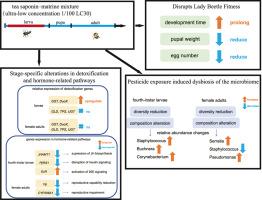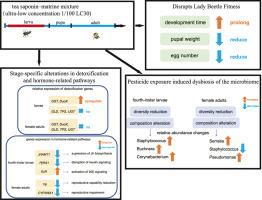Ultra-low concentrations of a botanical insecticide blend alter microbiota composition and gene expression in the ladybeetle Propylea japonica
IF 7.3
2区 环境科学与生态学
Q1 ENVIRONMENTAL SCIENCES
引用次数: 0
Abstract
Botanical pesticides are increasingly promoted as environmentally benign alternatives to synthetic chemicals in integrated pest management. However, the ecological safety of their persistent ultra-low residues remains poorly understood, particularly regarding non-target natural predators. In this study, we investigated the chronic toxicological effects of an ultra-low concentration (ULC; 1/100 of LC30 of 15.106 mg/mL) of a botanical pesticide mixture—composed of commercially available tea saponin and matrine mixed at a ratio of 10:1 (v:v)—on the generalist Propylea japonica. Long-term exposure significantly prolonged larval development, reduced pupal mass, and compromised female fecundity, indicating potential disruptions to population stability and biocontrol efficacy. Gene expression analyses revealed stage-specific alterations in detoxification and hormone-related pathways: fourth-instar larvae exhibited elevated expression of GST and DuoX, downregulation of JHAMT1 and PjIRS1, and upregulation of EcR, whereas adult females showed marked suppression of JHDK, FOXO, PjIRS1, and Vg. These changes point to endocrine disruption and impaired reproductive capacity. Moreover, 16S rRNA sequencing revealed that ULC exposure significantly decreased microbial diversity and altered symbiont composition, particularly in adult beetles. Collectively, our findings demonstrate that even ultra-low residues of botanical pesticides can impose sublethal physiological stress and reshape symbiotic microbial communities in beneficial insects. This work underscores the need for refined ecological risk assessments of green pesticides and advocates for pest management strategies that balance effective control with the conservation of natural enemies.


超低浓度的植物性杀虫剂混合物改变了瓢虫的微生物群组成和基因表达
植物性农药作为对环境无害的合成化学品替代品,在病虫害综合治理中日益得到推广。然而,其持续超低残留的生态安全性仍然知之甚少,特别是对于非目标自然捕食者。在这项研究中,我们研究了超低浓度(ULC; 1/100 LC30为15.106 mg/mL)的植物性农药混合物-由市售茶皂素和苦参碱以10:1 (v:v)的比例混合-对通虫丙烯的慢性毒理学效应。长期暴露会显著延长幼虫发育,减少蛹质量,降低雌性繁殖力,表明可能破坏种群稳定性和生物防治效果。基因表达分析揭示了解毒和激素相关途径的阶段特异性改变:四龄幼虫表现出GST和DuoX的表达升高,JHAMT1和PjIRS1的下调,EcR的上调,而成年雌性则表现出JHDK、FOXO、PjIRS1和Vg的明显抑制。这些变化表明内分泌紊乱和生殖能力受损。此外,16S rRNA测序显示,ULC暴露显著降低了微生物多样性和共生体组成,尤其是成虫。总的来说,我们的研究结果表明,即使是超低残留的植物性农药也会对有益昆虫施加亚致死的生理压力,并重塑共生微生物群落。这项工作强调了对绿色农药进行精细生态风险评估的必要性,并倡导在有效控制与保护天敌之间取得平衡的有害生物管理战略。
本文章由计算机程序翻译,如有差异,请以英文原文为准。
求助全文
约1分钟内获得全文
求助全文
来源期刊

Environmental Pollution
环境科学-环境科学
CiteScore
16.00
自引率
6.70%
发文量
2082
审稿时长
2.9 months
期刊介绍:
Environmental Pollution is an international peer-reviewed journal that publishes high-quality research papers and review articles covering all aspects of environmental pollution and its impacts on ecosystems and human health.
Subject areas include, but are not limited to:
• Sources and occurrences of pollutants that are clearly defined and measured in environmental compartments, food and food-related items, and human bodies;
• Interlinks between contaminant exposure and biological, ecological, and human health effects, including those of climate change;
• Contaminants of emerging concerns (including but not limited to antibiotic resistant microorganisms or genes, microplastics/nanoplastics, electronic wastes, light, and noise) and/or their biological, ecological, or human health effects;
• Laboratory and field studies on the remediation/mitigation of environmental pollution via new techniques and with clear links to biological, ecological, or human health effects;
• Modeling of pollution processes, patterns, or trends that is of clear environmental and/or human health interest;
• New techniques that measure and examine environmental occurrences, transport, behavior, and effects of pollutants within the environment or the laboratory, provided that they can be clearly used to address problems within regional or global environmental compartments.
 求助内容:
求助内容: 应助结果提醒方式:
应助结果提醒方式:


